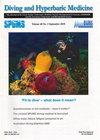Lung function changes in divers after a single deep helium-oxygen dive.
IF 0.8
4区 医学
Q4 PUBLIC, ENVIRONMENTAL & OCCUPATIONAL HEALTH
引用次数: 0
Abstract
INTRODUCTION This study measured pulmonary function in divers after a single helium-oxygen (heliox) dive to 80, 100, or 120 metres of sea water (msw). METHODS A total of 26 divers participated, of whom 15, five, and six performed a 80, 100, or 120 msw dive, respectively. While immersed, the divers breathed heliox and air, then oxygen during surface decompression in a hyperbaric chamber. Pulmonary function was measured twice before diving, 30 min after diving, and 24 h after diving. RESULTS At 30 min after the 80 msw dive the forced expiratory volume in 1 s (FEV₁)/forced vital capacity (FVC) ratio and the maximum expiratory flow at 25% of vital capacity (MEF₂₅) values decreased (89.2% to 87.1% and 2.57 L·s⁻¹ to 2.35 L·s⁻¹, P = 0.04, P = 0.048 respectively) but FEV₁/FVC returned to the baseline values by 24 h post-dive. Other pulmonary indicators exhibited downward trends at 30 min after the dive, but statistical significance was lacking. Interestingly, though several parameters decreased after the 100 msw dive, statistical significance was not reached. After the 120 msw dive, the FEV₁/FVC and MEF₇₅ decreased (90.4% to 85.6% and 8.05 L·s⁻¹ to 7.46 L·s⁻¹, P = 0.01, P = 0.007). The relatively small numbers of subjects who dived to 100 and 120 msw depths may explain the inconsistent results. The subjects diving to 100 and 120 msw were more trained / skilled, but this would not explain the inconsistencies in results between these depths. CONCLUSIONS We conclude that single deep heliox dives cause a temporary decrease in FEV₁/FEV and MEF25 or MEF₇₅, but these changes can recover at 24 h after the dive.单次深氦氧潜水后潜水员的肺功能变化。
引言:本研究测量了潜水员在单次氦氧(heliox)潜水至80、100或120米海水(msw)后的肺功能。方法:共有26名潜水员参与,其中15名、5名和6名分别进行了80、100和120米海水的潜水。在潜水过程中,潜水员在高压舱的表面减压过程中呼吸氦氧和空气,然后是氧气。潜水前、潜水后30分钟和潜水后24小时测量两次肺功能。结果:80 msw潜水后30分钟,1秒内用力呼气量(FEV₁)/用力肺活量(FVC)比率和肺活量25%时的最大呼气流量(MEF₂₅) 值下降(89.2%至87.1%和2.57L·s⁻cco至2.35升·秒⁻分别为,P=0.04,P=0.048),但FEV₁/FVC在潜水后24小时恢复到基线值。潜水后30分钟,其他肺部指标呈下降趋势,但缺乏统计学意义。有趣的是,尽管有几个参数在100 msw潜水后有所下降,但没有达到统计学意义。120 msw俯冲后,FEV₁/FVC和MEF₇₅ 下降(90.4%至85.6%和8.05L·s⁻cco至7.46升·秒⁻Pl,P=0.01,P=0.007)。潜入100和120 msw深度的受试者人数相对较少,这可能解释了不一致的结果。潜水至100和120 msw的受试者训练/技能更强,但这并不能解释这些深度之间的结果不一致。结论:我们得出的结论是,单次深层heliox潜水会导致FEV暂时下降₁/FEV和MEF25或MEF₇₅, 但这些变化可以在潜水后24小时恢复。
本文章由计算机程序翻译,如有差异,请以英文原文为准。
求助全文
约1分钟内获得全文
求助全文
来源期刊

Diving and hyperbaric medicine
医学-公共卫生、环境卫生与职业卫生
CiteScore
1.70
自引率
22.20%
发文量
37
审稿时长
>12 weeks
期刊介绍:
Diving and Hyperbaric Medicine (DHM) is the combined journal of the South Pacific Underwater Medicine Society (SPUMS) and the European Underwater and Baromedical Society (EUBS). It seeks to publish papers of high quality on all aspects of diving and hyperbaric medicine of interest to diving medical professionals, physicians of all specialties, scientists, members of the diving and hyperbaric industries, and divers. Manuscripts must be offered exclusively to Diving and Hyperbaric Medicine, unless clearly authenticated copyright exemption accompaniesthe manuscript. All manuscripts will be subject to peer review. Accepted contributions will also be subject to editing.
 求助内容:
求助内容: 应助结果提醒方式:
应助结果提醒方式:


